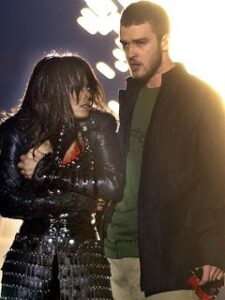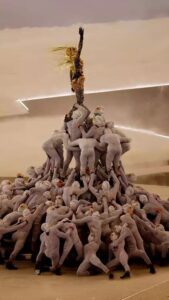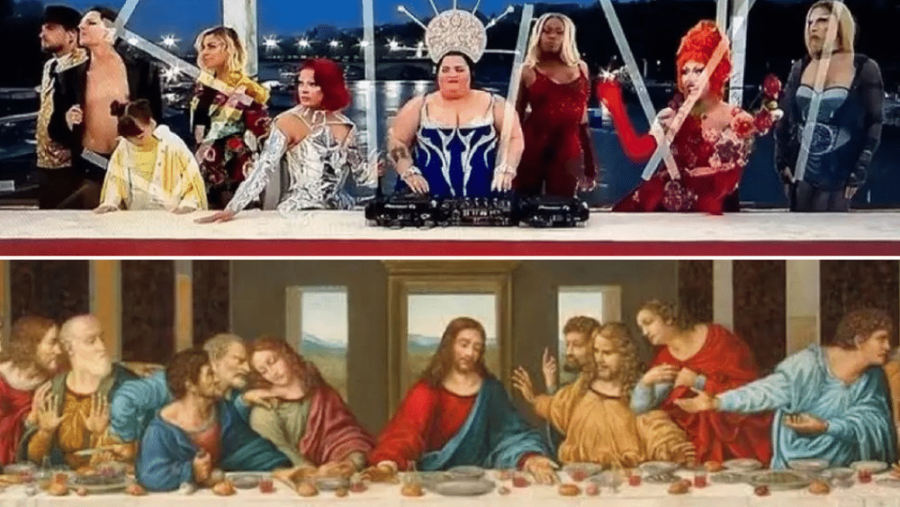The Paris Olympics pretty much lived up to their billing. The organizers planned well; not even a deluge during the opening pageant washed out the show. Gay Paree sparkled as never before. The spectacle was thoroughly French throughout, and fortunately there were few major problems. There were, however, some ominous glitches for those watching carefully and as is typical for these events, very disturbing symbolism also.
The reason these things are important is that these events are important. Since ancient times, all mass entertainment public spectacles have been civic liturgies. As “public works” (which is what “liturgy” means), these big shows are all highly ritualized performances that go far beyond mere entertainment. In ancient times, they were religious rites.
In the modern secular world, such works are primarily national sporting events, such as Superbowls with their halftime break shows; or global, including the opening and closing pageants of the Olympics. As opportunities to put a message into the brains of unimaginable numbers of viewers, they attract far more than just advertisers. These extravaganzas proudly put on display the sponsoring elite’s hopes, wishes, and fears, and thus, can be seen as attempts at either prophecy or sorcery.
As performances, however, they are subject to whims of fate or perhaps the gods: weather or a single mistake can wreck the most carefully planned and practiced show. This means such events might also serve as omens as well.
Both weather and mistakes happened this year. First, the parade was drenched in rain. Though it began shortly after the show got underway and only grew throughout the long flotilla, it didn’t interfere with any of the performances. Nor did it seem to dampen the spirits of the athletes in the first floating Parade of Nations down the Seine. Yet, rain on a parade is rarely considered a sign of divine approval, to say the least, though they did seem prepared.
Much more serious from a symbolic point of view, however, were glitches involving the Olympic and host nation flags. If “vexillomancy” (a term I think I just invented) has any oracular validity, then the omens for the next Olympics in LA were particularly bad. However, the editing of the broadcast was quite good — I doubt if most viewers caught any of the mistakes.
First, at the climax of the opening ceremony, the Olympic flag was raised upside down. As bad omens go, that’s pretty major, in my view. Some are saying it shows that the sorcerous intent of the cabal behind the show failed.
Then, during the closing ceremony, neither the Olympic, the French, nor the American flag managed to unfurl properly. They all hung on their poles like limp dishrags. This despite being raised on modern flagpoles which blow air to make sure the flags fly. The breeze ruffled their edges but failed to open them.
The final sign took place during Tom Cruise’s stunt where he leapt into the stadium. He yanked sharply several times on a cord attached to a pouch on his leg as he fell. But it failed to open. The pouch most likely contained an American flag, which did not materialize. Oops.
To summarize:
- The Olympic flag at the opening was hung upside-down — a universal sign of distress.
- The Olympic flag, that of the current host, and that of the future host all failed to unfurl during the closing ceremonies, which emphasize the continuance of the games.
- The future host flag also failed to appear during the hand-off stunt.
So if I were a betting person as well as being a superstitious one, I would not place a sou or anything else on LA 28 coming off as planned. Or maybe at all. Sorry. Perhaps a scandal will yet arise that will endanger the future of the games, or something else entirely.
But all that is quite minor compared to the much more serious symbolism presented in the Paris ceremonies, hidden behind the artsy avant-garde presentation.
In case of surprise

Had any disruption actually taken place, viewers might not know until much later. Because such an event had been used twenty years previously to make sure that the broadcasters would retain control. This was a result the infamous “nipplegate” scandal which marked the halftime show of Superbowl XXXVIII in February 2004. At the end of Justin Timberlake’s performance with Janet Jackson, he ripped open her top to momentarily reveal her breast.
Though the offending aureole was covered by tape or an ornament and immediately covered up, this “wardrobe malfunction”, as Timberlake casually dismissed it, nearly ruined Jackson’s career. Of course, establishment media were even more dismissive, blaming it all on poor planning, Janet’s attempts to revive her sagging career (no pun intended) and the entertainers’ later disagreements with the broadcaster.
But it immediately brought about a change in broadcasting standards so that innocent children would never be traumatized by the horror of a televised naked female breast again. A broadcast delay of some seconds was thus quietly mandated for all live TV events. (You can tell sometimes by switching channels during an event broadcast concurrently by several different stations like the State of the Union speech, where the broadcasts may be off from each other by a second or two.)
However implemented, delays allow networks to conveniently switch away not just in case of a flashing streaker or body part, but a terrorist attack, demonstration, unacceptable language, or for that matter, a UFO fly-by. Though a 20-second delay was used by ABC during Will Smith’s live slap of Chris Rock at the Academy Awards and its aftermath, it mattered little, as the smack instantly went viral.
However, the furor that erupted over nipplegate clearly shows the power of the public platform, as people are still talking about it twenty years later. But delays are not meant to censor intentional parts of the programming, however tasteless or controversial. So what caused the uproar in Paris this year was deliberately planned and allowed.
The scene on the Seine
At least since Hitler’s Olympics in Berlin in 1936, nations have used this global platform to shamelessly promote themselves and glorify their past. Paris in 2024 was certainly no exception, and France managed the event and all surrounding it — including the rebuilding of Notre Dame — to show off the best of their country.
Surely the timing of the Paris Olympics was perfect. Watching privileged youth come together to play peaceful games and perform astounding feats of skill and grace was something this tired old world needed — a reminder that not everything was old, grim, and deadly serious. Beats the hell out of war anyway…
The opening ceremony was as giddily French as can be imagined, and particularly played off Paris’ reputation of being the city of lights, music, joy and love, and a little naughtiness, too. Even the section celebrating romance gave a wink with a smiling implication of a ménage à trois.
Anyway, when it came to applauding Paris’ celebrated fashion industry, eyes were wide open. The catwalk across a bridge flaunted every flavor of model, of course. The observers were equally varied with an array of drag queens, including a person in a beard and a corset (the alchemical hermaphrodite, perhaps?) and a man interested in a child, all centering on a figure wearing a diadem with 7 rays. Not only was the layout obviously similar to Leonardo’s painting, the crown of the central transgender DJ is a clear reference to a solar deity’s halo. So it really was the Last Supper, despite the denials.
 Then as if to confuse things further, came a shot of a naked, blue-skinned man with a blond beard in the center of it draped in fruit and flowers. Supposedly this was Dionysus. (Who knew he was as blue as Krishna with a beard as blond as Thor’s? Ah, those artistes!)
Then as if to confuse things further, came a shot of a naked, blue-skinned man with a blond beard in the center of it draped in fruit and flowers. Supposedly this was Dionysus. (Who knew he was as blue as Krishna with a beard as blond as Thor’s? Ah, those artistes!)
The uproar was immediate, and not just from outraged Christians. After a week, even the Vatican admitted it was “saddened” by the sight. Of course, Thomas Jolly, the artistic director, claimed it was all a big misunderstanding and in any case, France is a bastion of artistic freedom, so there.
The concept was based on an unnamed painting, Jolly said, and the intent was “more to have a big pagan party linked to the gods of Olympus, Olympian, Olympianism … You’ll never find in me any kind of wish to mock, to denigrate anything at all. I wanted a ceremony that repairs and reconciles.”
Well, at least he said he was sorry that people were offended if not sorry for offending them.
Indeed, Dutch art historian Walther Schoonenberg was in no doubt of the scene’s perfect innocence. “The tableau vivant or ‘living painting’ in the opening ceremony of Paris 2024 was of The Feast of the Gods, by Jan van Bijlert from 1635.” The gods in the painting include Apollo, god of the sun, with his halo, Dionysus with grapes, Poseidon, god of the sea, armed with a trident, Artemis by the moon and Venus by Cupid. Minerva, goddess of wisdom, and Mars, god of war, were also present.
“So there is no question in this tableau of an insult to Christians,” the historian said. “We’re talking about the Olympic gods in a representation of van Bijlert’s work. The Greek gods came together on Olympus –- where the ancient Games took place.”
Such a reference seems legit. But, as a wiseguy who has engineered a few religious jokes in his own day, I can say with confidence that one always has a story or clever reference ready to disarm any muggles who get wise or are in any way offended by what they see. It’s not only necessary to have an out to save oneself if needed, it’s all part of the joke.
Notice, however, the Olympic tableau didn’t look much like that painting at all, but Leo’s Last Supper. In any case, equating the baccanalian orgy with the sacred feast of Christ merely makes the blasphemy explicit. The closing ceremony, however made it all perfectly clear.
From space it came
The serious symbolic part of the closing ceremony was called “Rebirth”. It began with the descent of a golden figure into a misty, barren, post-apocalyptic Earth. This “golden Voyager” was sheathed entirely in gold armor, almost insect-looking. Gold wires radiated from his shoulders like wings and others sprouted from his forehead like antennae — or perhaps horns?
As was explained during the broadcast, Jolly envisioned a dystopian future where the Olympic Games had disappeared, only to be reborn when a Golden Voyager visits. Jolly had previously said that the show was meant take spectators on a journey through time, exploring the foundations of humanity in a tribute to the creation of the Games and their revival by Pierre de Coubertin, the father of the modern Olympic Games, in the late 19th century.
Weirdly enough is that “Thomas designed the artistic character to represent the Voyager Golden Record, or the record of humanity sent to space by France in 1977, per the Associated Press,” (Yes, that’s not a vain boast — the French really did supply the disks that went on Voyager I and II.)

So is the scene either about the long gap between the ancient and modern games, or a prophecy about some distant future? Mythologically, it could mean both. But the deliberate ambiguity really means that all the action is symbolically occurring on a spiritual plane.
Anyway, the mysterious Voyager character fallen from heaven then searched the Earth for life, while gray-clad assistants descended from above to help. They looked like beefed-up, athletic mummies. So an angelic figure helped by the spirits of dead heroes, perhaps?
Slowly at his direction, they began to lift and move around some rings. Eventually these ascended above them, assembled to form the Olympic logo. All very well and good. But this did not seem to represent the triumph of the Olympic spirit in any age.
For then came the punchline: Beneath the rings, the figures quickly clambered together to form a tower or pyramid with the Voyager on top, arm raised. It was reminiscent of Nimrod on the Tower of Babel. “Voyager” therefore came not for humanity’s ascendance, but his own.
So there it is: An angel fallen from heaven uses enslaved spirits to build a symbol in the sky for his own glory. It thus appears that the Voyager is nothing less than the Antichrist. Well, Paris was well-known in the Nineteenth Century as a hotbed of Satanism, so perhaps it’s a final nod to French culture.
If that’s how it works, then the Los Angeles show should be a real Hollywood blockbuster… if it actually happens. But to understand the symbolic underpinnings of any such events, though, needs attention to the tiniest fleeting details from start to finish.
It should be noted that these images are already getting hard to find on the internet. Make of that what you will.

